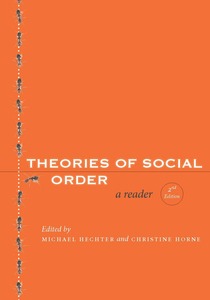Supplemental Readings
Markets
In our treatment of spontaneous order in the reader, we focus on theories that describe how the interactions of self-interested actors produce predictable, and sometimes desirable, social outcomes. The spontaneous order approach, however, incorporates a variety of evolutionary arguments.
One type of argument focuses on the evolution of physical traits. For evolutionary psychologists, the brain, like any other body part, is subject to evolution. Thus, by thinking about the environment in which human beings evolved, we can gain insight into how the brain works. Those traits that were adaptive in the environment in which the bulk of human evolution occurred were selected for and can be observed in people today (though they are no longer necessarily adaptive). With better understanding of these traits, we can develop superior explanations of social behavior. Here, biological/genetic evolution is used to explain universal human characteristics that in turn can help to understand social phenomena.
Other scholars take the mechanisms at work in genetic evolution and apply them to explain social phenomena. Just as physical traits that are not adaptive die out, so do social practices. Those practices that are adaptive persist, those that are not fade. The extent to which these kinds of arguments apply to groups and not simply to individuals is disputed. Traditionally, genetic evolutionary arguments treat the individual as the unit of selection. Those individuals who carry non-adaptive traits die. Those individuals with adaptive traits survive and reproduce, thus passing on their traits to the next generation. Some researchers argue that a similar approach can also explain group traits. That is, those groups that have adaptive practices will survive while those whose practices are dysfunctional will fail.
Finally, some scholars argue that social practices can better be explained by models of cultural evolution — not by transplanted genetic evolution arguments. For these scholars, practices and ideas are transmitted from person to person. In a pure genetic model, individual actors are “born” with a trait; those with non-adaptive traits die. In cultural models, individual actors learn and change over the course of their life. As a result of their interactions, they may shift from holding non-adaptive beliefs, practices, and so forth to adhering to others that produce superior outcomes. While genetic and cultural models have many similarities, they may produce different predictions.
Each of these types of evolutionary explanations falls within the family of spontaneous order approaches. The list of supplemental reading includes examples.
Alchian, Armen. 1950. "Uncertainty, Evolution and Economic Theory." Journal of Political Economy 58:211-221. Argues that profit maximization is impossible under uncertainty. Hence, social scientists ought not to rely on internal states (motives) for their analysis; instead, in the face of uncertainty, success is most likely attained by imitating those who are already successful.
De Waal, Frans. 1996. Good Natured: The Origins of Right and Wrong in Humans and Other Animals. Cambridge: Harvard University Press. Argues that norms arise in the course of biological evolution.
Friedman, BenjamIn M. 2005. The Moral Consequences of Economic Growth. New York: Alfred A. Knopf. Argues that economic growth increases generosity and is essential for healthy society.
Henrich, Joseph and Natalie Henrich. 2007. Why Humans Cooperate: A Cultural and Evolutionary Explanation. Oxford: Oxford University Press.
Johnson, Steven. 2001. Emergence: The Connected Lives of Ants, Brains, Cities, and Software. New York: Scribner. Describes many contexts in which interaction leads to predictable patterns.
Lyall, Sarah, 2005. “A Path to Safety with no Signposts,” New York Times, January 22: 4 Discusses the work of Hans Monderman, a Dutch traffic engineer who uses principles of spontaneous order to create designs that improve traffic conditions in Friesland. His ideas are being adopted in a number of European countries.
Macy, Michael W. and John Skvoretz. 1998. “The Evolution of Trust and Cooperation among Strangers: A Computational Model.” American Sociological Review 63(5): 638-660. Uses a genetic evolution approach to explore the emergence of cooperation and trust among strangers.
Macy, Michael W. and Robert Willer. 2002. “From Factors to Actors: Computational Sociology and Agent-Based Modeling.” Annual Review of Sociology 28: 143-166. Reviews the sociological use of agent-based models (computer simulations) to explain emergent social structure and social order.
Mark, Noah. 2003. “The Cultural Evolution of Cooperation.” American Sociological Review 67(3): 323-344. Uses a cultural evolution approach to explain cooperation.
Polanyi, Karl. 1943. The Great Transformation. Boston: Beacon Press. Classic theoretical and empirical critique of the theory of spontaneous order as applied to the laissez-faire policies of early nineteenth-century Britain.
Scott, James C. 1998. Seeing Like a State: How Certain Schemes to Improve the Human Condition Have Failed. Argues that state-led attempts to engage in social engineering -- to rationalize and deconstruct spontaneous orders, replacing them with planned orders -- are doomed to fail.
Wilson, David Sloan. Darwin’s Cathedral: Evolution, Religion, and the Nature of Society. Chicago: University of Chicago Press. Supports group selection approaches. Argues that religion — that is, a complex system of norms -- is adaptive for groups and that it results from evolutionary pressures.
Links
The Santa Fe Institute. www.santafe.edu/index.html. A multidisciplinary research center with a focus on emergence processes.
Human Behavior and Evolution Society. www.hbes.com. An interdisciplinary group of scholars who rely on evolutionary approaches to understand human nature.
Society for Evolutionary Analysis of Law (S.E.A.L.) http://law.vanderbilt.edu/seal/. An interdisciplinary group of scholars with an interest in law, biology, and evolution.
http://www.princeton.edu/~icouzin/. Iain Couzin looks at how the actions of individuals intersect to produce macro-level patterns across species.
